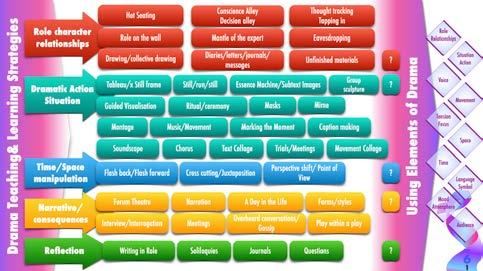
2 minute read
The Elements of Drama
Role, character, relationsh
Role: when we step into someone else’s shoes, someone we are not but pretend to be, we are in role. Role is general rather than specific, e.g. we might be a police officer or a nurse or a parent.
Advertisement
Character: when we portray the voice and movement of a specific person.
Characterisation involves identification and portrayal of a person’s values and attitudes, intentions and actions as imagined relationships, situations and ideas in dramatic action.
Relationships: the connections and interactions between people that affect the dramatic action
Situation
Elements are the essential parts of something. When we make Drama they are the fundamental building blocks used. When we respond to Drama we look at how the Elements are used.
Focus &Frame
Situation: the setting and circumstances of the roles, characters and relationships. The situation often carries the story or plot of what happens in the Drama.
Tension
Focus: directing and intensifying attention and framing moments of dramatic action
Frame: the perspective or focus of the dramatic action.
Voice and Movemen
Tension: creating a sense of anticipation or conflict within characters or character relationships; presenting through drama problems, surprise and mystery in stories and ideas to propel dramatic action and create audience engagement. We identify and use tension of: task and challenge; opposing people, ideas, points of view, forces and circumstances; physical, mental and emotional oppositions; providing constraints; the unknown; anticipation and suspense; limiting space and time.
Space and Time
Meaning
Voice and movement are tools for making dramatic action.
Voice: using and varying our voice expressively to create roles, situations, relationships, tension, focus, atmosphere and symbols
Movement: using and varying facial expression, posture and action in space and time expressively to create roles, situations, relationships, tension, focus, atmosphere and symbols
Egaugnal
Drama draws together
Drama takes place in space and time.
Space: there are 3 dimensions of space in Drama:
• the physical space of the performance and audience
• the fictional space of the dramatic action
• the emotional space between characters
Time: in Drama time can be:
• fictional time in the narrative or setting;
• timing and managing time in dramatic action
• juxtapositioning of one moment to the next contributing to the tension and rhythm of dramatic action
Audience
Language and ideas: the choice of words and ideas to create dramatic action
Dramatic meaning: capacity to manipulate the other elements of Drama to express and communicate; the ability to identify and interpret the actual and implied, intended and perceived ideas and feelings
Mood and atmosphere: the feelings or tone of physical space and dramatic action created by or emerging from the performance
Symbol: objects or ideas to create associations to reinforce or extend dramatic
Audience is the experience of watching and listening to drama; making meaning of what is seen and heard and interpreting how it works.
The Elements of Drama work dynamically together to create and focus dramatic action and dramatic meaning. Drama uses movement and voice along with language, symbol and ideas to explore roles, characters, relationships and situations. Dramatic action is shaped by focus and framing, dramatic tension, space and time, mood and atmosphere to symbolically present and share human experiences for audiences.
ActivAte your leArning
• Make a poster for your students about the Elements of Drama



